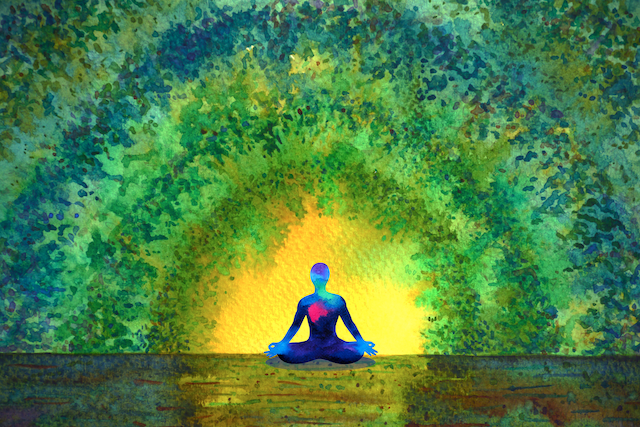
“You change for two reasons: Either you learn enough that you want to, or you’ve been hurt enough that you have to.” ~Unknown
I learned about boundary work when I was teaching in the NYC jails with male prisoners.
After driving onto a maximum security island of electric, clanging gates, I encountered metal detectors, hallways filled with yelling, chaotic inmates, and tension and anxiety in the air that was almost tangible.
I started my workday tensed up and ended it drained, exhausted, and overwhelmed.
In other areas of my life, the same thing was happening. In my personal relationships, I couldn’t find the edges where I ended and others began. I sometimes felt powerless, unsure of who I was in relationships, and unheard. I wasn’t sure how to change my life, but I knew that I had to.
Because I didn’t set healthy personal boundaries, I was exhausted, I couldn’t focus, and I felt consumed by drama around me, in both my personal and professional lives. As I result, I dealt with a lot of conflict, failed to take care of myself, and generally disliked my work.
Since I knew I loved my work, I took some time to reflect on why my job wasn’t working for me. I then decided to try some experimenting.
I started doing a little boundary and grounding work each morning before I even entered each facility. At the end of each day, before I went home to my baby, I did a short releasing meditation in my car.
It worked so well that I began to notice a marked difference in the flow of the classes I taught, my relationships with my students, and my overall enjoyment of the day. I left energized and excited by my work, as opposed to drained and burnt out.
I was able to go home and be completely present with my daughter instead of taking my day with me and letting it creep into our evening.
My boundary work has been crucial in my personal relationships, as well. As I started doing this work to protect myself and center myself in the jails, I realized that I could do it with the people in my personal life, too.
I began to see immediate effects in my relationships, as well as in the quality of my everyday life.
Even though I no longer work in prisons and jails, I still do this work just about every morning. When I let it slip, when I don’t take time to ground myself and honor my boundaries, I can feel a big difference.
Nowhere has this work impacted my life more than in my personal relationships. I used to feel like every person who I spent a lot of time with blew me around as I got caught up in their life. I noticed myself taking on aspects of their personalities and lifestyle and losing myself.
After doing this work, I now surround myself with people who are really attracted to me because of who I am. How I show up in the world: by my strength, my motivation, my passion—how absolutely me I am.
And I stay me. It’s not even a struggle. I am centered in who I am and what I love and I have my boundaries in place, so the people and circumstances around me can’t shake that.
If you’d also like to maintain healthy boundaries to feel more centered, these three steps will be a good start:
1. Check your personal engine light.
Think about how you feel when you’re around someone who drains you and upsets you, someone with whom you feel you lose yourself. How does this feel in your body? How does it feel in your mind? How does the presence of this person affect you?
Now look at this list of feelings and sensations you’ve made, and imagine that your body is like a car, with a dashboard full of warning lights.
You’ve just identified what I like to call the “check engine light” for your personal boundary system. It’s a security system warning that your personal energy field has been breached, and you’re letting in stuff that isn’t yours.
This is really important. When our boundaries are weak, unguarded, or unclear, we let in all sorts of stuff that isn’t actually our stuff, and we give away our own personal energy unconsciously.
That means you’re dealing with a breach of your energetic security system and a leak of your own personal energy. You’re looking at warning signs indicating that some work needs to be done, some boundaries need to be shored up, and you need to return to center.
2. Ground yourself as preparation for maintaining boundaries.
Grounding is akin to the way a tree sinks her roots to stay secure in a storm. It’s the first tool in creating healthy boundaries—nurturing a connection with ourselves, our centers.
Our root system is both our anchor and our boundary system. It keeps us from being blown about in other people’s winds. It gives us a way to focus and still ourselves to connect with our heart and our intuition. That’s what keeps us steady and connected and focused.
There are as many ways to ground as there are people. I like to take five minutes to actually imagine my root system connecting me into the earth, like a giant oak tree. Here are some other ideas:
- Meditating
- Saying a prayer, affirmation, or mantra in the shower in the morning
- Offering a blessing over your morning meal or beverage
- Chanting or repeating affirmations in your head as you walk to work or school
Try different ways—you’ll find the one that works for you!
3. Notice the people and places that tend to drain you.
Before entering those places or exposing yourself to those people, take a few minutes to imagine breathing a bubble of protective energy around you. Think of it as a space that will only allow love and positivity inside it, deflecting anything else. Really see it and really feel the force of it around you. Then recognize what you need to do to maintain that space.
These three steps will help you create and maintain healthy boundaries. Building boundaries is like any muscle or practice—the more you work with it, the better it serves you!
About Britt Bolnick
Britt Bolnick is the owner of In Arms Coaching, heart-centered life coaching for women. You can connect with her at www.InArmsCoaching.com.













 Though I run this site, it is not mine. It's ours. It's not about me. It's about us. Your stories and your wisdom are just as meaningful as mine.
Though I run this site, it is not mine. It's ours. It's not about me. It's about us. Your stories and your wisdom are just as meaningful as mine. 